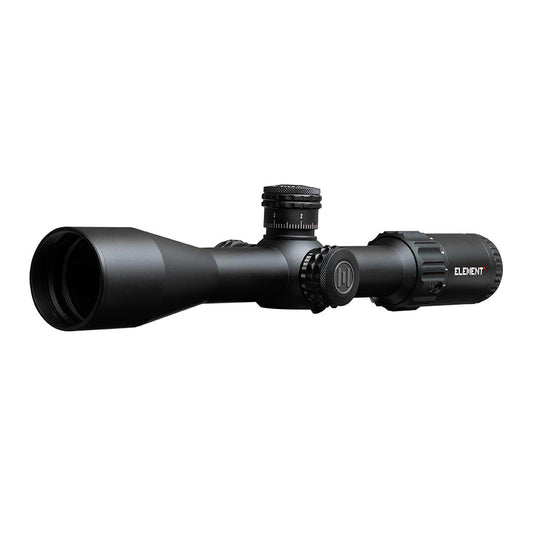

Element Optics Helix 4-16x44 FFP APR-2D MOA Riflescope 50047 features a first focal plane (FFP) design that adjusts the reticle size as you zoom in or out, allowing for accurate range estimation and holdovers at all magnification levels. This riflescope is tailored for precision shooting, whether at the range or in the field. Built to perform in varying conditions, it seamlessly adapts to different shooting scenarios, ensuring consistent accuracy regardless of your target distance.
Constructed for durability, the Element Optics Helix withstands the demands of tactical and recreational shooting with ease. Weighing just 23.8 ounces, it combines portability with advanced optics that deliver bright and clear images even in low-light environments. With MOA adjustments for precise tuning, this riflescope is ideal for shooters who prioritize performance and reliability in their gear.
Features:
- FIRST FOCAL PLANE for precise holdovers at any magnification.
- VERSATILE MAGNIFICATION ranging from 4x to 16x to adapt to any shooting scenario.
- EXCEPTIONAL CLARITY with advanced optics for bright, vivid images in all conditions.
- DURABLE CONSTRUCTION ensures long-lasting performance in rugged environments.
- MOA ADJUSTMENTS provide precise, repeatable adjustments for ultimate accuracy.
- WIDE FIELD OF VIEW allows for better tracking of moving targets.
- LIGHTWEIGHT DESIGN (23.8 oz) enhances portability without sacrificing quality.
- USER-FRIENDLY TURRET SYSTEM facilitates easy adjustments for quick target acquisition.
Technical Specifications Table
| Specification | Details |
|---|---|
| SKU | 50047-EOptics |
| Magnification Range | 4x - 16x |
| Lens Diameter | 44mm |
| Weight | 23.8 oz (675g) |
| Exit Pupil | 13.5-3.3mm |
| Eye Relief | 3.7” |
| Field of View | 26.2-6.55 ft @ 100 yds |
| Length | 360mm (14.2”) |
| Reticle Position | First |
| Scope Tube Size | 30mm |
What’s in the Box?
- Element Optics Helix 4-16x44 FFP APR-2D MOA Riflescope
- Lens covers
- Padded case
- User manual
Customer Reviews
"The clarity at long distances is incredible! I can easily make my shots count." - John D.
"Lightweight and durable. Perfect for my tactical needs." - Sarah L.
"The first focal plane feature is a game changer!" - Mike T.
FAQ
What makes the FFP reticle better than a second focal plane reticle? The FFP reticle allows for accurate range estimation at any magnification level, making it ideal for long-range shooting. This means you can quickly adjust your aim without worrying about reticle size changes.
Is the Element Optics Helix suitable for both hunting and competitive shooting? Absolutely! This versatile scope is designed for various shooting scenarios, making it perfect for both hunting and competitive environments. With a solid build and precise adjustments, it adapts to your shooting needs.
Similar Models
If you’re seeking more from Element Optics, explore our full collection including the Element Optics Titan 5-25x56 FFP for enhanced long-distance capabilities and the Element Optics Nexus 3-18x50 FFP for a more compact option. Find the perfect scope tailored to your shooting adventures!
You May Also Like
Here’s some of our most similar products people are buying. Click to discover trending style.







